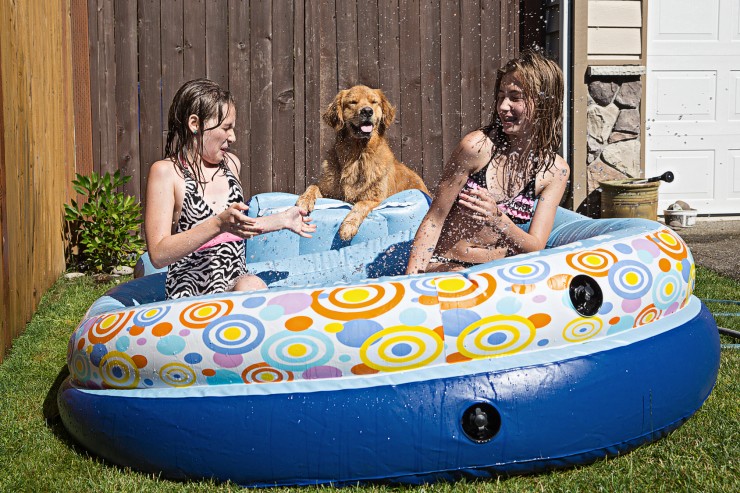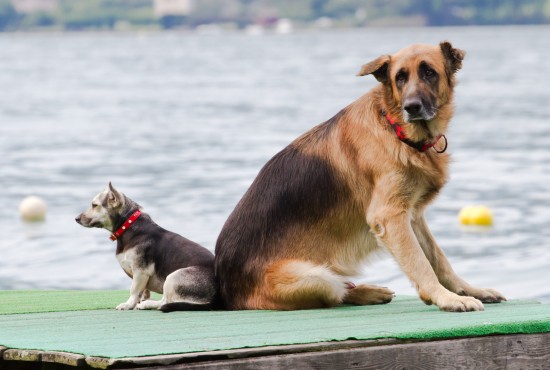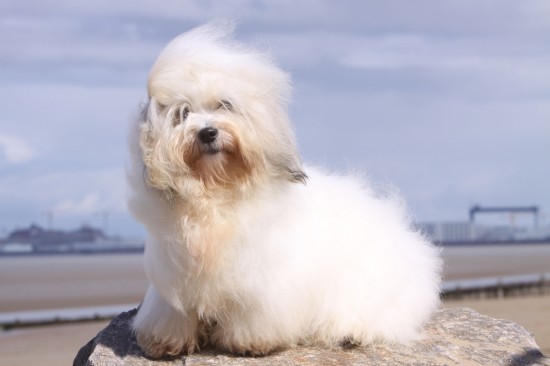

When the weather hots up during the summer months, man and beast alike tends to head for shaded areas and water to cool down and regulate their body temperature. This means that many of us will set up a paddling pool or even a larger pool in the garden during the summer, which can be great fun for adults, kids and dogs as well. However, water in ponds or pools with sheer sides can be potentially hazardous to dogs, although there are many ways to keep them safe and enjoyable too, providing that you stay vigilant.
In this article, we will look at considerations to bear in mind when it comes to enjoying ponds, pools and summer safety for dogs. Read on to learn more!
If you’re just setting up a temporary paddling pool or small swimming pool, the chances are that you will be using plain old tap water to do so, and this is fine! However, unless you use a food-grade hosepipe to fill the pool with, it is important to note that the plastic and rubber of most hosepipes can leach potential toxins into the water carried through them, and while this very rarely causes a problem, it is a good idea to bear it in mind.
If your pool endeavour is rather more involved or you are lucky enough to have a proper hot tub or Jacuzzi outside, these are often treated with chemicals to make the water safe, and so you should consider how this may affect your dog’s coat and skin.
Most paddling pools and ponds have sheer sides, which may mean that your dog (and smaller children) cannot just step right into them with ease. If your dog cannot jump in and out of the pool without help, you must remain mindful of this, and ensure that your dog does not get stuck in the pool, unable to get out and rapidly running out of puff to keep swimming.
The water depth is something else to bear in mind; if your dog cannot stand up on the floor of the pool and keep their head comfortably above the water, they will need someone with them and dedicated to keeping an eye on them at all times, who is able to get them in and out and ensure that they are not getting into difficulties.
It comes as a surprise to some dog owners to learn that not all dogs are physically able to swim, and you should check out this article to find out if your dog may be one of them. Dogs that cannot swim are still perfectly capable of enjoying your pool, paddling and splashing about, but you should ensure that they can keep their head above the water at all times, and that they do not get out of their depth or panic. Never leave a non-swimming dog unsupervised in or around water; they might bite off more than they can chew, or take a dive for the paddling pool to cool off!
Unless the sides of your pool are very shallow and you know that your dog can jump in and out as they wish to because they have already done this several times, your dog should be supervised by an adult at all times when they are in the vicinity of water. Older children may be perfectly capable of supervising your dog when they are in the garden or in the pool, but do not expect younger children, with their shorter attention spans, to be able to keep a weather eye on your dog when their safety relies upon it.
Even if you have a lush, appealing pool full of apparently clean water, you should still ensure that you don’t neglect your dog’s proper water supply, and encourage them to drink from their proper bowl rather than the pool. Even if the water looks clean and fresh, it is highly unlikely that you will empty and refill the pool every day, and of course, people and dogs getting in and out of it will all take in dirt and debris with them!
Also, bear in mind that most hosepipes are not designed to decant potable water, so stick to your tried and trusted water sources for drinking.
Letting your dog paddle or get into the water can go a long way towards helping to keep them cool, which is vitally important when the weather is hot! However, just because your dog is in the water does not mean that they are protected from the sun, and heatstroke, sun burn and other concerns are still a potential risk.
Make sure that your dog spends plenty of time in the shade and can always chill out when they want to, and if they have a very fine coat or white fur, consider using a sun screen on them.
 Dog Pig Hunting – How to get started
Dog Pig Hunting – How to get started
Hunting p
Dog Pig Hunting – How to get started
Dog Pig Hunting – How to get started
Hunting p
 Do Large Dogs Have Larger Brains And Higher Intelligence Levels Than Small Dogs?
Do Large Dogs Hav
Do Large Dogs Have Larger Brains And Higher Intelligence Levels Than Small Dogs?
Do Large Dogs Hav
 10 Dog Breeds That Boast Moustaches & Beards
10 Dog Breeds Tha
10 Dog Breeds That Boast Moustaches & Beards
10 Dog Breeds Tha
 Learn The Virtues Of True Friendship With A Companion Dog
Learn The Virtues Of True Friendship With A Companion Dog
Learn The Virtues Of True Friendship With A Companion Dog
Learn The Virtues Of True Friendship With A Companion Dog
 What Causes Gallstones In Dogs?
What Causes Galls
What Causes Gallstones In Dogs?
What Causes Galls
Copyright © 2005-2016 Pet Information All Rights Reserved
Contact us: www162date@outlook.com